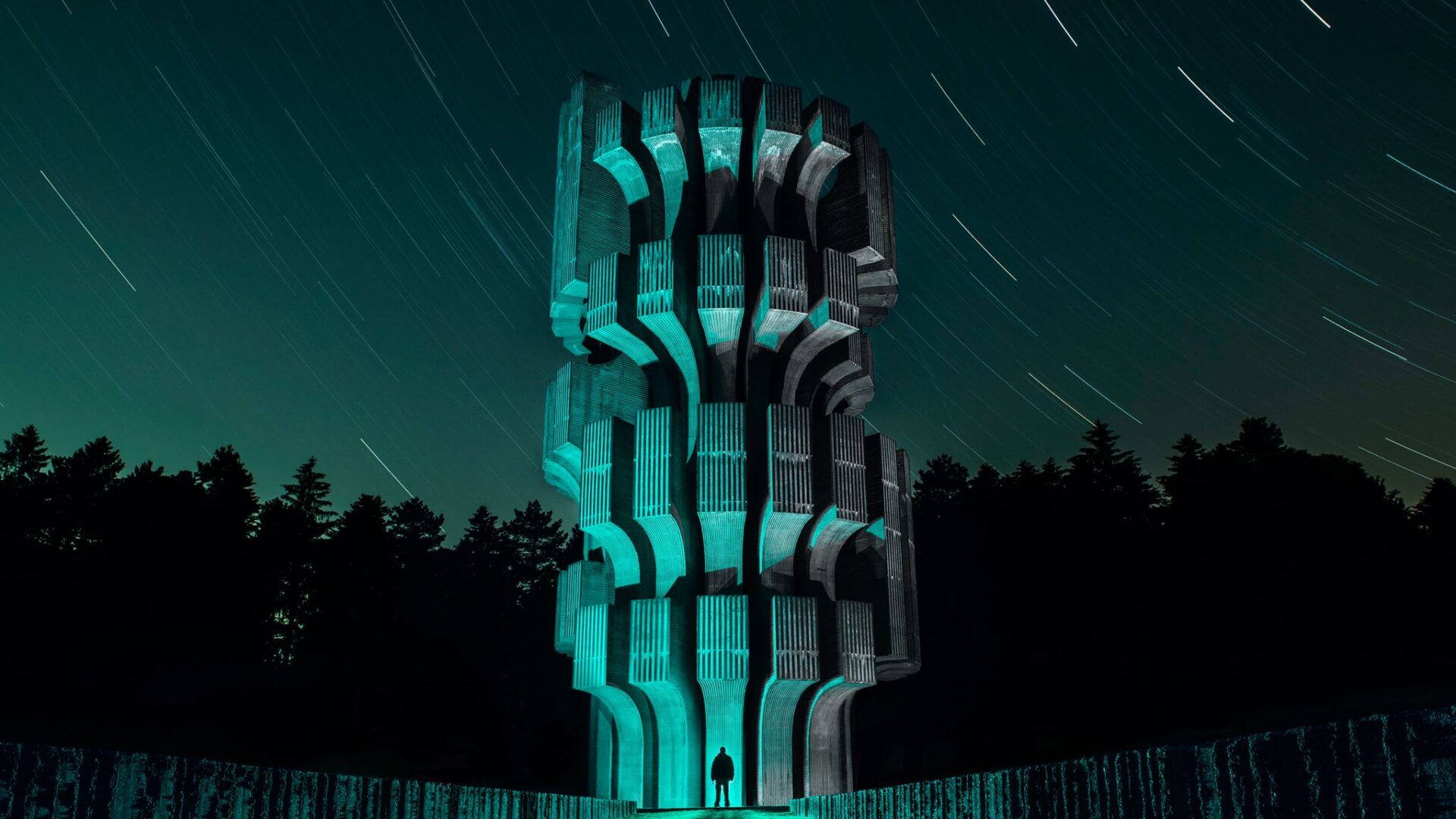INEXHAUSTIBLE EDITIONS: SOUNDING SPOMENIK PROJECT
Unheard Stories: Sonic Aspects of Yugoslavia’s Brutalist Monuments
Wien Modern 2023 | INEXHAUSTIBLE EDITIONS: SOUNDING SPOMENIK PROJECT
Unheard Stories: Sonic Aspects of Yugoslavia’s Brutalist Monuments | echoraum | Vienna, Austria [01/12/2023]
Original Drone Video Footage: balkan.stories | Video Art: Belma Bešlić-Gál | Composition: Snæfellsnes (2012) by Belma Bešlić-Gál | Produced by echoraum in co-production with Wien Modern, in cooperation with KUD Mreža and ON Rizom | Inexhaustible Editions | SKICA
Yugoslav World War II monuments and memorials
If one were to encapsulate the philosophical, cultural, and ideological essence of Yugoslav monuments in a single quotation, then the most fitting choice in my opinion would be the one from Bogdan Bogdanović in his statement to the Serbian Academy of Sciences and Arts, on the work done so far in year 1972: “In my search for a way out of the world of modern architecture, which is strange and unfamiliar to me, I came across a special area of architecture where there is neither modern nor not modern, in which there is only the ETERNAL.”
Spomeniks are a series of memorials built from the late 1950s -1990s in the Socialist Federal Republic of Yugoslavia, whose primary intent was to honor its people’s antifascist resistance during the People’s Liberation Struggle (1941-1945) against Axis occupation and oppression forces. What is very important to me is to emphasize that the Yugoslav Spomenik sites are, in almost every single case, mass graves.
Yugoslav Spomeniks can be percieved as the extreme forms of what Foucault defined as Heterotropia, or places that are experienced as different, distinct from the rest of the spatial and temporal reality.
The use of otherworldly forms allows for interpretive flexibility that goes beyond official narratives, especially in today’s post-Yugoslav socio-economical context. Where the original message is no longer recognizable, they invite a variety of associations – one could perceive them as emissaries from distant stars or as elements from a parallel universe. By evoking a utopian moment, these monuments translate the promise of the future into a universal gesture.
Most of these monuments were built on the locations of historic battles of World War II, and because of that, they are located in the open spaces, mostly far away from town or city centers. When we look at the map of their locations, they sort of form “an invisible network of symbolic places” (Gal Kirn).
The Yugoslav Spomeniks are not meant to represent struggle and death, but to symbolize life, resistance and the vibrant energy that fueled these efforts; they are forward-looking and mark the emergence of a new progressive society of which they are the product.
Belma Bešlić-Gál: Unheard Stories – Sonic Aspects of Yugoslavia’s Brutalist Monuments [2023]
Belma Bešlić-Gál: Unheard Stories: Sonic Aspects of Yugoslavia’s Brutalist Monuments [Presentation_Screenshots]
PROGRAMME@wienmodern2023
19:00 Uhr: Exhibition Opening | Photo Exhibition „Concrete Lines“ | Video installation „Stands Still, the Monument by Janez Lenassi“
“Unheard Stories: Sonic Aspects of Yugoslavia’s Brutalist Monuments“, a lecture by Belma Bešlić-Gál
Federal Republic of Yugoslavia. While their distinctive and somewhat enigmatic appearance has attracted worldwide attention and has been the subject of extensive research in recent years, almost nothing is known about their intrinsic acoustical properties that represent an equally fascinating area for exploration. In the year 2021, Edition FriForma, an offshoot of the record label Inexhaustible Editions, embarked on an enduring endeavor to unearth the aural characteristics of the Spomeniks of former Yugoslavia by uncovering their sonic properties and capturing random ambient sounds through site-specific field recordings.
„From Planning To Execution“, a talk with sound engineer Jernej Babnik Romaniuk and producer László Juhász, moderated by Belma Bešlić-Gál
20:30 Uhr: Performances
„Ilisrka Bistrica“, solo cello performance by Tadeja Žele, multi-channel sound distribution and live visualization by Patrick K.-H.
The improvised solo set is highly inspired by the memory and atmosphere of the performer’s recording session that took place in August 2021 at Janez Lenassi’s iconic monument in Ilirska Bistrica in Slovenia. The solo cello performance is accompanied by a multi-channel sound distribution of the actual and unmanipulated field recordings by Patrick K.-H. that were captured at the location during Žele’s recording for Sounding Spomenik.
„Dražgoše“, solo saxophone performance by Vida Vatovec, multi-channel sound distribution and live visualization by Patrick K.-H.
Vida Vatovec’s alto saxophone solo is also improvised, however, undeniably inspired by her experience of the half-day recording session that happned in August 2021 at architect Boris Kobe and sculptor Stojan Batič’s three-level breathtaking memorial complex in Dražgoše. Again, the performance is complemented by Patrick K.-H.’s multi-channel sound distribution of field recordings captured in and around the architecture where Vatovec recorded for Sounding Spomenik.
PARTICIPANTS
Tadeja Žele: Violoncello
Vida Vatovec: Alto Saxophone
Anton Iakhontov a.k.a. Patrick K.-H.: multi-channel sound projection, live visuals
Laszlo Juhasz: Curator, Project Management
Jernej Babnik Romaniuk: Field Recordings
Belma Bešlić-Gál: Lecture, Artist Talk

Sounding Spomenik_live@echoraum
INEXHAUSTIBLE EDITIONS: SOUNDING SPOMENIK PROJECT | wien modern 2023 |
Sounding Spomenik Photos: Markus Sepperer
